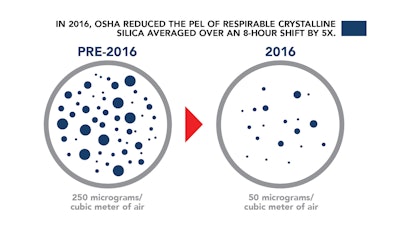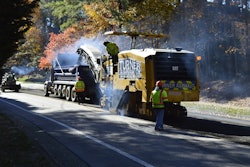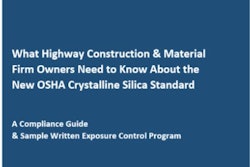
The U.S. Department of Labor’s Occupational Safety and Health Administration delayed enforcement of the crystalline silica standard that applies to the construction industry several months to conduct additional outreach and provide educational materials and guidance for employers. Enforcement will begin in September.
The Occupational Safety and Health Administration issued a final rule on silica dust exposure in early 2016, with the goal to curb lung cancer, silicosis, chronic obstructive pulmonary disease and kidney disease in America's workers by limiting their exposure to respirable crystalline silica. The rule is comprised of two standards, one for Construction and one for General Industry and Maritime.
Key provisions
- Reduces the permissible exposure limit (PEL) for respirable crystalline silica to 50 micrograms per cubic meter of air, averaged over an 8-hour shift (previous limit was 250 micrograms).
- Requires employers to: use engineering controls (such as water or ventilation) to limit worker exposure to the PEL; provide respirators when engineering controls cannot adequately limit exposure; limit worker access to high exposure areas; develop a written exposure control plan, offer medical exams to highly exposed workers, and train workers on silica risks and how to limit exposures.
- Provides medical exams to monitor highly exposed workers and gives them information about their lung health.
- Provides flexibility to help employers — especially small businesses — protect workers from silica exposure.
OSHA estimates that the rule will save over 600 lives and prevent more than 900 new cases of silicosis each year, once its effects are fully realized. The Final Rule is projected to provide net benefits of about $7.7 billion, annually.
About 2.3 million workers are exposed to respirable crystalline silica in their workplaces, including 2 million construction workers who drill, cut, crush, or grind silica-containing materials such as concrete and stone, and 300,000 workers in general industry operations such as brick manufacturing, foundries, and hydraulic fracturing, also known as fracking.
Employers must limit worker exposure Robert Bosch Tool Corporation
Robert Bosch Tool Corporation
Most employers can limit harmful dust exposure by using equipment that is widely available — generally using water to keep dust from getting into the air or a ventilation system to remove it from the air. The rule provides greater compliance assistance to construction employers — many of which run small businesses — by including a table of specified controls they can follow to be in compliance.
Table 1 matches common construction tasks with dust control methods, so employers know exactly what the need to do to limit worker exposures to silica. Dust control measures listed in the table include methods known to be effective, like using water to keep dust from getting into the air or using ventilation to capture dust. In some operations, respirators may also be needed.
One example listed in the table illustrates required practices for using handheld power saws. If workers are sawing silica-containing materials, they can use a saw with a build-in system that applies water to the saw blade. The water limits the amount of respirable crystalline silica that gets into the air.
Employers who follow Table 1 correctly are not required to measure workers’ exposure to silica and are not subject to PEL.
Employers who do not use control methods in Table 1 must:
- Measure the amount of silica that workers are exposed to over an eight-hour day.
- Protect workers from respirable crystalline silica exposures.
- Use dust controls to protect workers from silica exposures above the PEL.
- Provide respirators to workers when dust controls cannot limit exposures to the PEL.



















